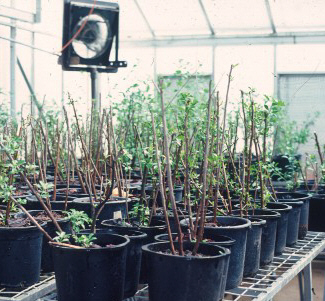|

Plants being grown from stem cuttings.
|
There are many types of vegetative propagation including; tissue culture, cuttings, layering,
marcotting, grafting, rhizomes, stolons, division, etc. Of these, cuttings (leaf, tip, stem, roots), are most commonly used.
Irrespective of the propagative form selected, factors to be considered
include the following:
 | High levels of hygiene are required.
|
 | Turgidity and freshness of material for propagation must be maintained and the material planted as soon as possible after collection, as this will enhance the chances of root development and establishment.
|
 | Which plant material is used and when is taken for propagation will be determined by the species and the intended use of the material. The material may be used to;
 | boost plant numbers quickly, |
 | propagate identical specimens, |
 | rejuvenate old woody stock lacking in vigour, or |
 | produce mature, flowering, miniature specimens of large-growing species.
|
|
 | A root promoting hormone such as indole acetic acid, indole butyric acid or naphthalene acetic acid should be used. These are available in liquid or powder and in varying strengths for specific purposes.
|
 | Use bottom heat, which speeds callous formation and root development and so reduces chances of pathogen infection. |
Seasonal changes can affect the root development
capacity of cutting material. Different material may be needed at
different times to achieve success. For example, young tips may be used
during active growth periods or semi-hard greenwood or hardwood during
dormant times. Cuttings of many species generally behave very poorly or
fail completely if taken when specimens are in a reproductive phase of
growth. See the example of vegetative propagation:
cuttings of Adriana tomentosa. |

